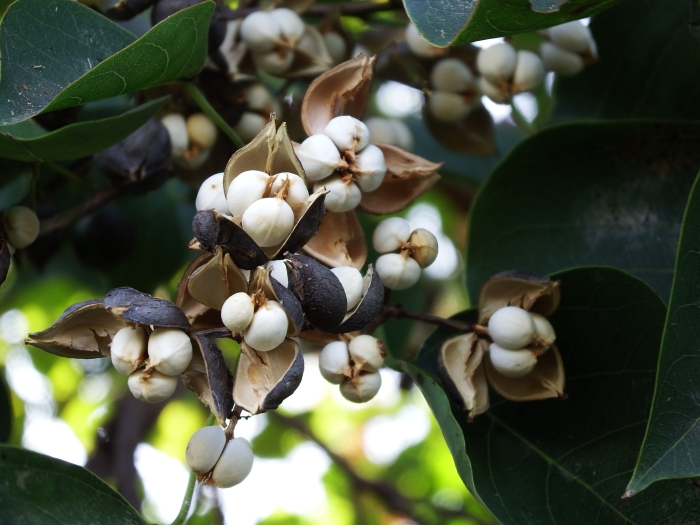Chinese Tallow
(Triadica sebifera)
Chinese Tallow (Triadica sebifera)
/
/

高山田鼠
CC BY 4.0
Image By:
高山田鼠
Recorded By:
Copyright:
CC BY 4.0
Copyright Notice:
Photo by: 高山田鼠 | License Type: CC BY 4.0 | License URL: http://creativecommons.org/licenses/by/4.0/ | Rights Holder: 高山田鼠 | Publisher: iNaturalist | Date Created: 2019-11-13T15:33-08:00 |




















































Estimated Native Range
Summary
Triadica sebifera, commonly known as Chinese Tallow, is a deciduous tree native to wetlands and marshy areas in Southeastern China, Taiwan, and Japan. It typically grows to a height of 30-40 feet and a width of 25-30 feet. The tree has a moderate to fast growth rate and forms an attractive, rounded canopy. Its leaves are heart-shaped with a pointed tip, turning a brilliant array of colors in the fall, from yellow to red and purple, rivaling the autumnal display of maples. The flowers, which are light green, appear in terminal spike-like inflorescences up to 20 cm long and are conspicuous in the spring, typically maturing from April to June. The fruit, a three-lobed capsule, ripens from September to October and is attractive to birds.
Chinese Tallow is valued for its ornamental qualities, including its showy fall foliage and fast growth, providing quick shade. It is adaptable to a range of soil types, including poor soils, and is not particular about drainage, though it prefers moist conditions. This tree is often used in urban settings, residential gardens, and as a street tree. It thrives in full sun to part shade and requires medium amounts of water. However, it is known to have invasive tendencies when planted outside its native range, spreading aggressively in areas like the southern United States, where it displaces native vegetation and alters ecosystems. It is also susceptible to pests such as the Chinese tallowtree aphid and diseases like sooty mold. Gardeners should be cautious and check local regulations before planting, as it is considered invasive in many regions.CC BY-SA 4.0
Chinese Tallow is valued for its ornamental qualities, including its showy fall foliage and fast growth, providing quick shade. It is adaptable to a range of soil types, including poor soils, and is not particular about drainage, though it prefers moist conditions. This tree is often used in urban settings, residential gardens, and as a street tree. It thrives in full sun to part shade and requires medium amounts of water. However, it is known to have invasive tendencies when planted outside its native range, spreading aggressively in areas like the southern United States, where it displaces native vegetation and alters ecosystems. It is also susceptible to pests such as the Chinese tallowtree aphid and diseases like sooty mold. Gardeners should be cautious and check local regulations before planting, as it is considered invasive in many regions.CC BY-SA 4.0
Plant Description
- Plant Type: Tree
- Height: 30-40 feet
- Width: 25-30 feet
- Growth Rate: Rapid
- Flower Color: N/A
- Flowering Season: Spring, Summer
- Leaf Retention: Deciduous
Growth Requirements
- Sun: Full Sun
- Water: Medium
- Drainage: Medium, Slow
Common Uses
Bee Garden, Bird Garden, Drought Tolerant, Erosion Control, Salt Tolerant
Natural Habitat
Wetlands and marshy areas in Southeastern China, Taiwan, and Japan
Other Names
Common Names: Tallowtree , Candleberry Tree , Popcorntree , Chinese Tallowtree , Chinesischer Talgbaum , Árbol Del Sebo , Boiré , Arbre À Suif , Kasumbi , Pau-Do-Sebo
Scientific Names: Sapium sebiferum , Triadica sebifera , Stillingia sebifera , Excoecaria sebifera , Sapium chihsinianum , Croton sebiferum , Sapium pleiocarpum , Carumbium sebiferum , Croton macrocarpus , Croton macrocarpus publ
GBIF Accepted Name: Triadica sebifera (L.) Small